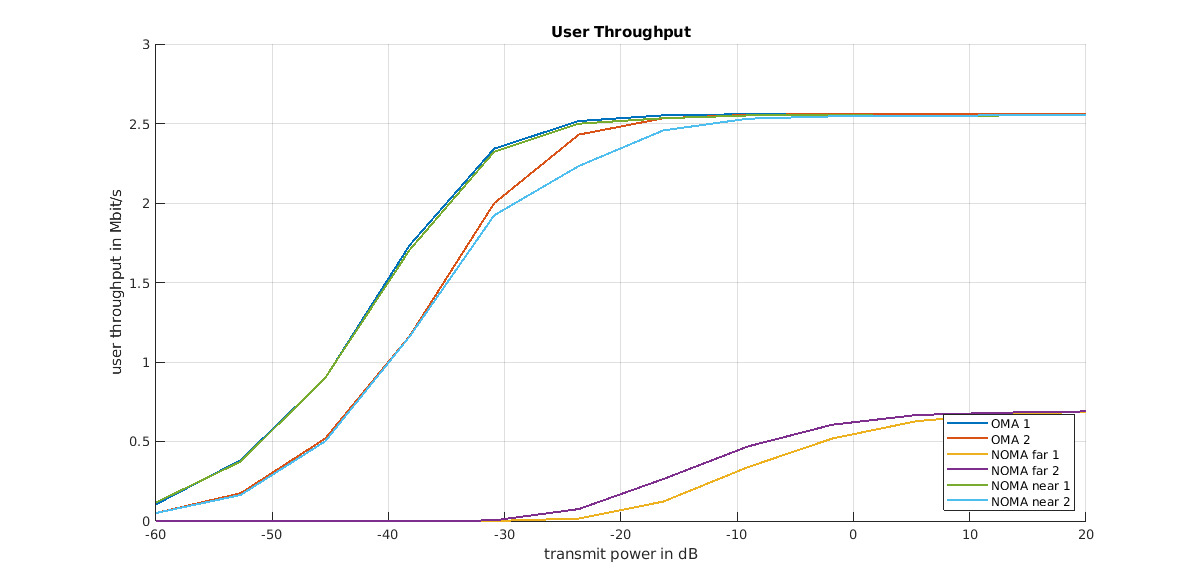Hi,
Reference NOMA Scenario figure 2 which shows User Throughput vs Transmit Power in dB, I have few questions, if you could please answer them:
The Unit on x-axis is dB or dBm?
How power allocation is done?
How the throughput is calculated?
Why after 2.5 Mbit/s(near) and 0.7Mbit/s (far) the user throughput get’s saturated even the power is increasing?
Why do we get the benefit? The main reason behind getting advantage by using NOMA?

Hello,
Please find the answers below.
The Unit on x-axis is dB or dBm?
How power allocation is done?
- The power allocation is governed by the power share factor alpha, which is set by the multi-user superposition transmission (MUST) index.
How the throughput is calculated?
- The post-equalization SINR equations for the NOMA scenario are specified in Section 8.9.4 of the user manual. The post-equalization SINR is computed by the LQM, and then, this is passed to the LPM for the throughput calculation.
Why after 2.5 Mbit/s(near) and 0.7Mbit/s (far) the user throughput get’s saturated even the power is increasing?
- The throughput saturates as it is limited by the maxCQI parameter of the far users and by the maximum CQI of 15 for the near users.
Why do we get the benefit? The main reason behind getting advantage by using NOMA?
- NOMA offers high spectral efficiency by allowing to serve multiple users on the same resources.
Regards,
Charmae
Thanks Charmae, Why the MaxCQI parameter is set, isn’t it limiting the throughput, what if we don’t set it or set it to a value that it should not saturate the throughput?
Regards,
Farhan
Hi Farhan,
The parameter is set to 6 to be more comparable to MUST, which fixes the far user CQI to 6. If you don’t set it, it is set to the default value (found in scenarios.example or parameters.Noma file). You can also change its value to see what happens.
Regards,
Charmae
Hi Charmae,
Thanks for your answer, I am actually wondering how power allocation is done for near and far user? I can see the power share factor is chosen according to the MUST index and 3GPP TS 36.211 Table 6.3.3-1, but I am not sure how it actually works. What these below values represents or how are they interpreted?
% [MUSTIDx x ModulationType]
obj.powerShareTable = [ 8/10, 32/42, 128/170; …
50/58, 144.5/167, 40.5/51; …
264.5/289, 128/138, 288/330];
For example what is the power value of a Near user and it’s corresponding Far User at a particular point in time? IF you can please elaborate it. Thanks!
Hi Farhan,
The table specifies the power allocation factor of the far user (alpha_far), which depends on the modulation order used by the near user. The table also indicates the corresponding MUST index for that power allocation factor.
From this, you get the power allocation factor of the near user: alpha_near = 1 – alpha_far.
Regards,
Charmae
Hi Charmae,
Thanks for the reply, Reference Table 6.3.3-1 , for example MUSTIdx 01 and Modulation QPSK does 8/10 represents value of alpha_far? If you can please explain a bit. Thanks!
Regards,
Farhan
Hi Charmae,
Isn’t power value be in dB like from -60 to 20 dB, how 8/10 translates into this value?
Regards,
Farhan
Hi Farhan,
The alphas are power allocation factors for sharing the transmit power. They are not the actual power values.
Regards,
Charmae
Hi Charmae,
What are the actual power values? Does alphas have any relation with layer mapping?
Regards,
Farhan
Hi Farhan,
Version 1.2 of the simulator only supports two-user SISO power domain NOMA (downlink). As in my past reply, the alphas are power allocation factors to share the transmit power (i.e., the near user gets alpha_near share of the BS transmit power, while the far user gets alpha_far share). This means you get the power values by multiplying the transmit power by these share factors.
Regards,
Charmae
Thanks, I want to ask Can we run NOMA with MIMO in the 5G SL Simulator?
In addition to my above question, does the SL Simulator support contiguous block or non-contiguous blocks? Moreover, does the carrier frequency corresponds to Licensed bands? for the 3.6-3.8 GHz bands Licensed bands what will be the carrier frequency?
Hi Farhan,
Can we run NOMA with MIMO in the 5G SL Simulator?
- NOMA with MIMO is not yet supported. We plan on including it in the upcoming summer release.
Does the SL Simulator support contiguous block or non-contiguous blocks?
- If you are referring to carrier aggregation, the simulator does not support it. The simulator just assumes that the spectrum used for data transmission is one contiguous block of spectrum.
Does the carrier frequency corresponds to Licensed bands?
- The carrier frequency corresponds to the carrier frequency set in the scenario files. If you want to be in a licensed band, you should set a carrier frequency and bandwidth that is in that licensed band (the simulator does not check this).
Regards,
Charmae
Thanks, Can I get a list of what is planned for upcoming summer release?
